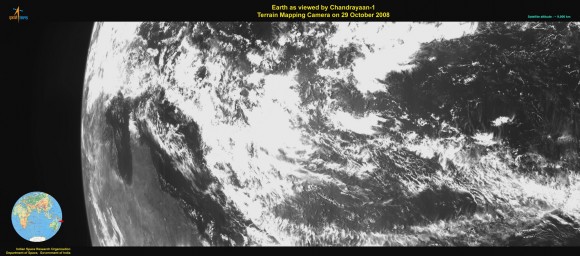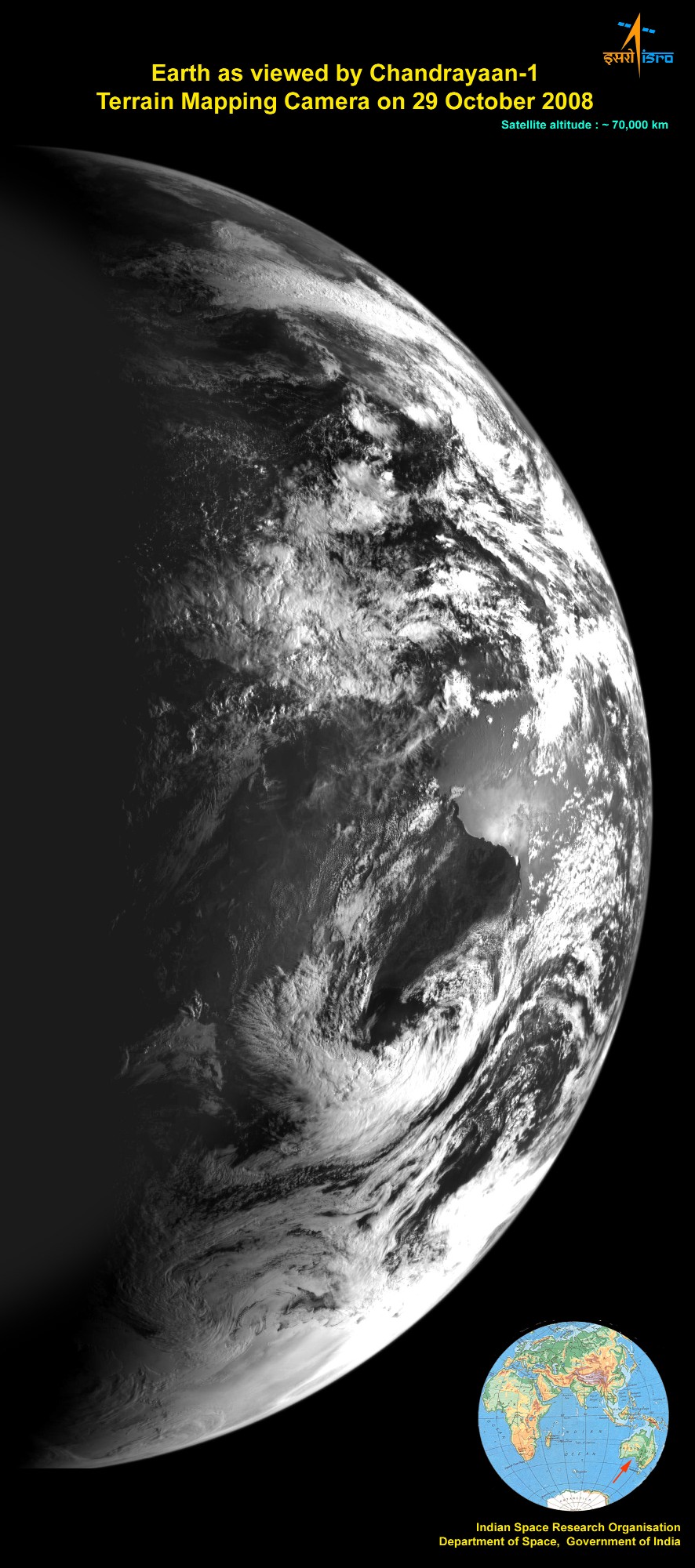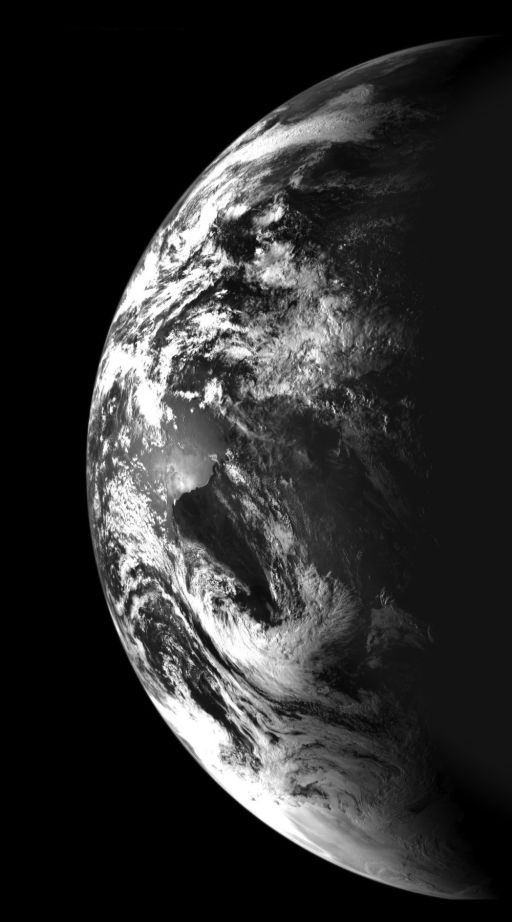[/caption]
While the Chandrayaan-1 spacecraft wends its way to the Moon with gradually longer elliptical loops around the Earth, mission scientists decided to test out the main camera on board, the Terrain Mapping camera (TMC). The camera snapped this picture of Earth on October 29, 2008, at a distance of 70,000 km, showing Australia. If you’re having a hard time making out the image, it might be because the image is flipped, as though looking at it in a mirror. Emily Lakdawalla over at the Planetary Society blog figured this out and has flipped the image for us (see below). Why is the original image backwards? Emily explains, “Data doesn’t come down from spacecraft in familiar formats like JPEG or TIFF; it’s a stream of ones and zeroes, with a format unique to the science instrument, and scientists and engineers write their own software for translating that into raw image data. There are varying conventions for whether bits are written right or left, and if you take that raw image data and open it up in a piece of off-the-shelf image processing software, the image might be backwards.” As Emily says, the error is not really important. The image is beautiful, and gives reason for great anticipation of the first images it will return of the moon.
In the meantime, there’s another, closer image of Earth from 9,000 km, too…
Here’s the image from 9,000 km:

TMC is one of the eleven scientific instruments on Chandrayaan-1. The camera can take black and white pictures of an object by recording the visible light reflected from it. The instrument has a resolution of about 5 metres.
And here’s Emily’s “visually correct” version of the original Chandrayaan-1 image:
Chandrayaan-1 will execute one more maneuver to raise its orbit, and send the spacecraft to the vicinity of the moon at a distance of about 384,000 km from the Earth. Once the Chandrayaan-1 spacecraft reaches the vicinity of the Moon, the spacecraft will be slowed sufficiently to enable the gravity of the moon capture it into an elliptical orbit. The spacecraft will make observations from the initial orbit, and then the orbit will be lowered a 100 km circular polar orbit. Following this, the Moon Impact Probe (MIP) will be ejected, impacting the lunar surface. Then the main mission will commensce, with Chandrayaan-1 exploring the moon from orbit with its array of instruments for two years.
More about Chandrayaan-1.
Source: ISRO



Why are these images not in color?
Probably because you don’t need colour to get data out of a grey satellite. Remember: this is a moon probe.
It seems to me like lots of labor and cost could be saved by standardizing on image formats and satellite firmware and hardware. Why re-invent the camera every time we send up a satellite? Let’s hear it for cost over-runs! 😉
Grayscale offers 4 times better resolution. Since this camera is primarily used to gather terrain features, grayscale is a much better choice.
Color is often the better choice for distance and panoramic pictures, or when you wish to use the spectrum for composition analysis.
I always get tripped up by images like this – I confuse the subject with the ground.
Have been since year five or so when I first saw a picture of Denmark from space in our geography book and everyone laughed at me for not being able to see it.
Kendall, one of the reasons is that illumination levels differ dramatically from world to world (distance to the Sun and all that jazz). If you have to prepare your camera for all possible light environments it might find in the Solar System, it has to become much more complex (and probably much heavier) than anything that has been made so far.
Another reason is that different science goals demand different things from the imaging software. Again, you just can’t prepare one camera for all possible science goals in space missions.
Still, there are examples of reuse. Some instruments do get recycled between missions.
Not bad for first light… Keen to see it get to the moon for some science ops…
The “gravity of the moon” will not “capture it into an elliptical orbit.” That’s not how it works. Space is effectively frictionless, so if an object approaches a moon or planet, without crashing or entering the atmosphere, then it will return to the same spot in space relative to the moon/planet, or will reach the same distance as it speeds away.
The way a spacecraft goes into orbit is by doing an engine burn to lose speed, which most efficiently occurs when the object is at closest approach (periapsis). This burn puts the spacecraft into orbit, it’s not somehow captured later.
Tom Saxton:
The “gravity of the moon” will not “capture it into an elliptical orbit.” That’s not how it works. . . . [The spacecraft does] an engine burn . . . it’s not somehow captured later.
So, when we hear about a planet capturing asteroids and such with its gravity, effectively making them moons, then that’s just all bull? I don’t know if Chandrayaan-1 will “do an engine burn” or not (although that’s how man-made objects are generally put into orbit, so I *guess* it will). But are you trying to say that the physics of space do not allow a large body to gravitationally capture satellites?; because that is plainly an incorrect assertion.
Great. I can’t wait to see the moon images. Sounds like they’re doing a great job there.
More clearly, the craft is traveling fast enough to escape the gravitational pull of the moon as it approaches. For something to be captured by a planet it has to either be on a collision course, or it has to be traveling slowly enough to be captured. The craft has to slow down or it would simply slingshot out into space.
Hugh Jars: Tom is right. Asteroids can do one of three things when approaching a planet:
a. Slam straight into it.
b. Miss it by enough that it continues on past it.
c. Come close enough to enter the upper atmosphere, modifying its path enough that it enters orbit.
So what you are talking about sort of happens sometimes, but only rarely and under the correct parameters, and not strictly because of gravity. Confusion arises in the simplification and use of layman’s terms, I think. Th effect of gravity is not enough when the relative approach speed is high. Poor explanation, but best I can do.
Hugh Jars: Tom is right. Asteroids can do one of three things when approaching a planet:
a. Slam straight into it.
b. Miss it by enough that it continues on past it.
c. Come close enough to enter the upper atmosphere, modifying its path enough that it enters orbit.
So what you are talking about sort of happens sometimes, but only rarely and under the correct parameters, and not strictly because of gravity. Confusion arises in the simplification and use of layman’s terms, I think. Th effect of gravity is not enough when the relative approach speed is high. Poor explanation, but best I can do.
What does it mean that the camera has a resolution of about five meters? Obviously a five-meter object may be one pixel at a given distance, but more pixels when closer, and less when further.